
 |
|
|
#1 |
|
All the news that's fit to excerpt
Name: newsie
Location: who knows?
Join Date: Jun 2008 Motorcycle(s): only digital replicas Posts: Too much.
|
[cycleworld.com] - 2022 Le Mans MotoGP Report
Front-tire drama and talk of ending aerodynamic aids.
Click here to view on their site. 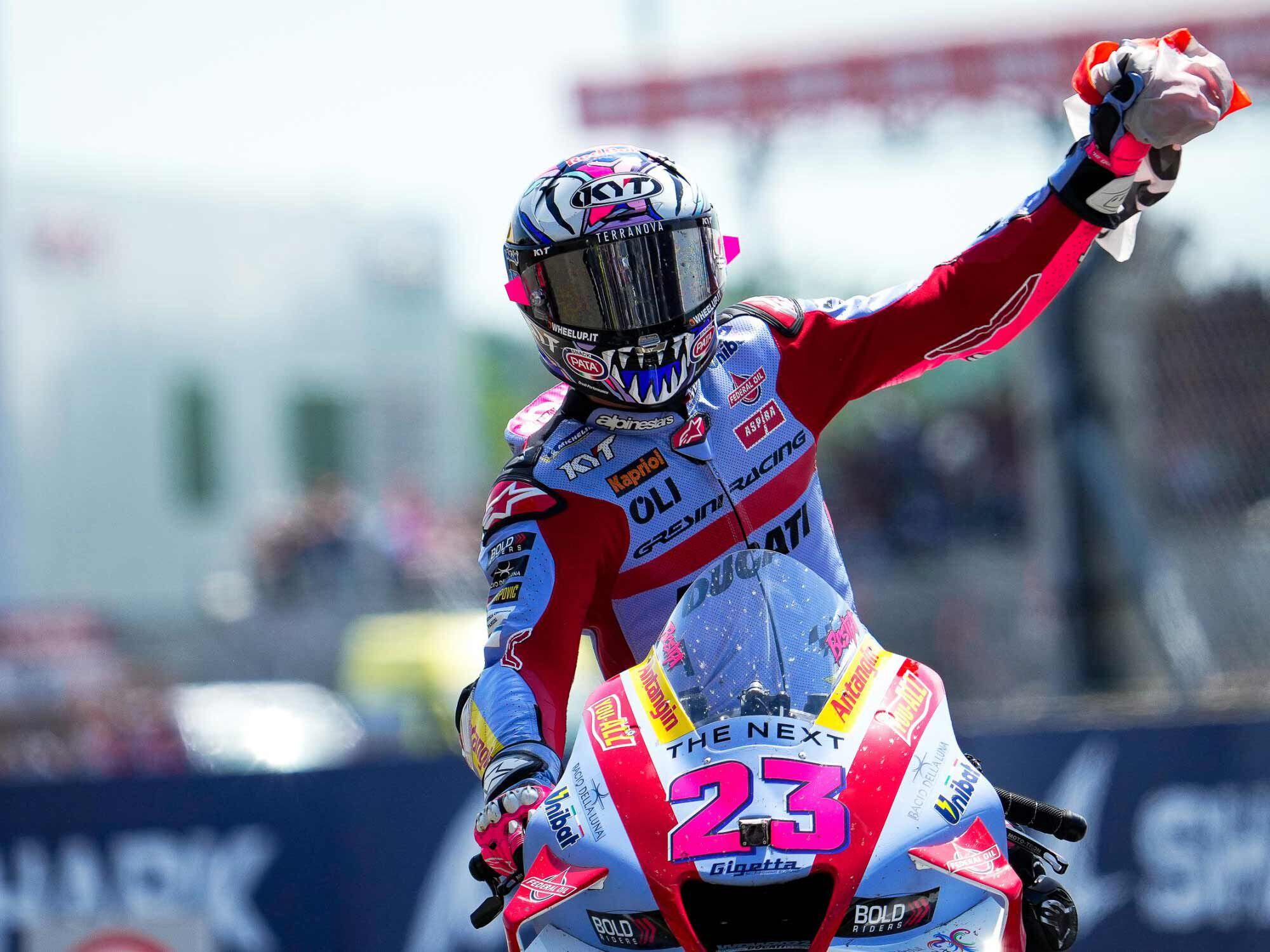 Ducati’s Enea Bastianini played the long game at Le Mans, and it paid off with his third victory of the season. He has closed to just eight points behind the series leader, Fabio Quartararo. (MotoGP/)Last year it was Yamaha’s Fabio Quartararo who led the learning race early in the season. Ducati’s Francesco Bagnaia caught up rapidly, and by the end nearly took the championship. This weekend at Le Mans many riders crashed, including Bagnaia, even though he won the pole and set a new lap record. A mad start and opening laps put Ducatis 1-2-3 after Suzuki’s Álex Rins crashed out on lap three and everyone exercised caution because of the slippery track. Just after half distance Enea Bastianini seemed to decide his own pace was costing him less in the form of mistakes than was Bagnaia’s. That is the situation in which one rider may attempt to “break” another—to set a pace that forces the other rider to accept a rising level of mistakes. Eventually these threaten to get out of hand, or force the rider to slow down. It worked. In a thoroughly planned manner, Bastianini passed Bagnaia in the second half of the race, Bagnaia returning the favor. Another exchange saw Bagnaia go wide, losing time; in his efforts to recoup, he crashed out on lap 21. That makes three wins for Bastianini out of six races this year. Aprilia’s Aleix Espargaró, third behind Ducati-mounted Jack Miller, had Quartararo right behind him, requiring an error-free run to the finish in order to keep the Yamaha man from squeezing past. Johann Zarco, on yet another Ducati, completed the top five. Espargaró said, “I knew that today would be a race of survival—the track was very slippery. It was more difficult to follow someone than to be fast on the track [on your own] today. Every time I got close to Jack the bike moved a lot in front. The front wheel had a very high temperature—I could see it from the dash. So I decided to leave [him] about one second in front…” 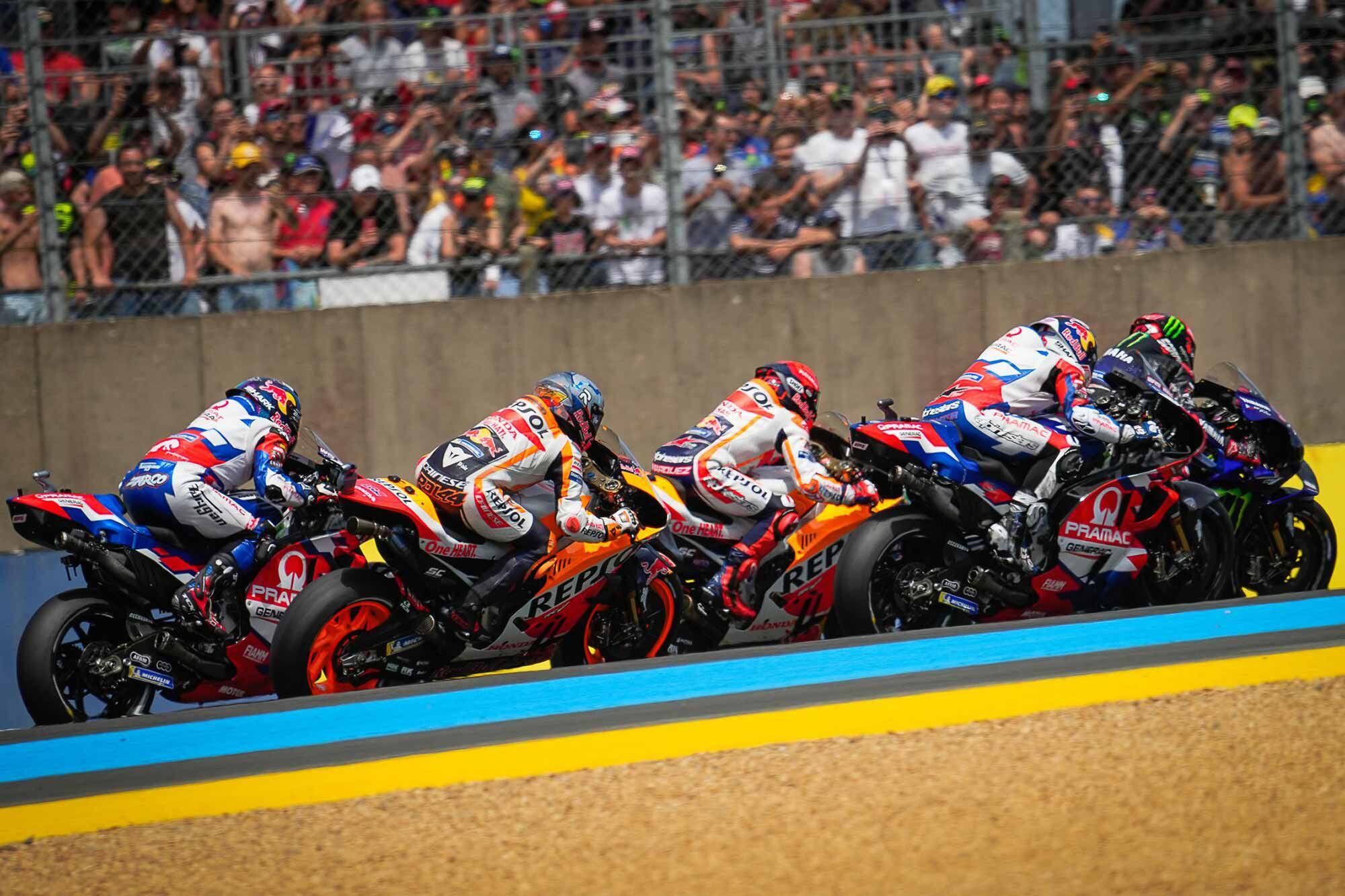 Dorna likes close racing, because it believes that brings about more spectator engagement. How’s this for close? More and more this season, we’re seeing up to 20 riders a second apart. (MotoGP/)Now that the first block of overseas tracks is behind, it may be that some of the “normalcy” many have expected has come to pass. Bagnaia won two weekends ago and was among the fastest in Le Mans practice. The top five qualifiers were those you’d expect: Bagnaia, Miller, Aleix Espargaró, Quartararo, and Bastianini. Front-Tire Problems Riders said that the track was slippery, making overtaking difficult, because most passing occurs during braking. But they also expressed that there has been a chronic problem with overtaking since the beginning of the season. First there has been talk of front-tire overheating during close drafting, which I wrongly attributed to the hot exhaust and heated radiator air that stream back from the lead bike. Now Marc Márquez has defined the issue: “…when you follow someone closely with the new aerodynamics… you don’t have the downforce driving [your own] aerodynamics [to increase front grip] so you push more on the tire and the temperature increases. This becomes more critical over the years.” Only the front tire is so affected—not the rear. Tire-Pressure Controversy Add to this the controversy arising from a document which revealed that, for many laps this season, leading riders have run front-tire pressures below Michelin’s “gentleman’s agreement” of 28 psi front, 25 psi rear. A total of 18 riders are said to have run such “illegal” low pressures. Riders want to start low, because they know that pressure climbs in early laps as the tires come to operating temperature, and that if close drafting takes place, pressure will climb further—perhaps so high the tire becomes “hot and bouncy.” When that happens it doesn’t recover by “resting” for a couple of laps. Until a complete and accurate picture of this behavior exists, requiring an arbitrary range of front-tire pressures is like King Canute commanding the tide to go back. The tire manufacturer well knows that a tire, made sufficiently hot by any cause, may blister (caused by vaporization of oils or waxes in the tread compound, and resulting in a tread “pimple”) or chunk (fair-sized pieces of tread rubber being flung off the tire after a temperature-driven failure of the carcass-to-tread bond). Chunking was behind Barry Sheene’s horrific 1975 accident in Daytona practice, which was caught on film. Such outcomes are corporate PR disasters, to be avoided at all costs. More secrecy! More rules! 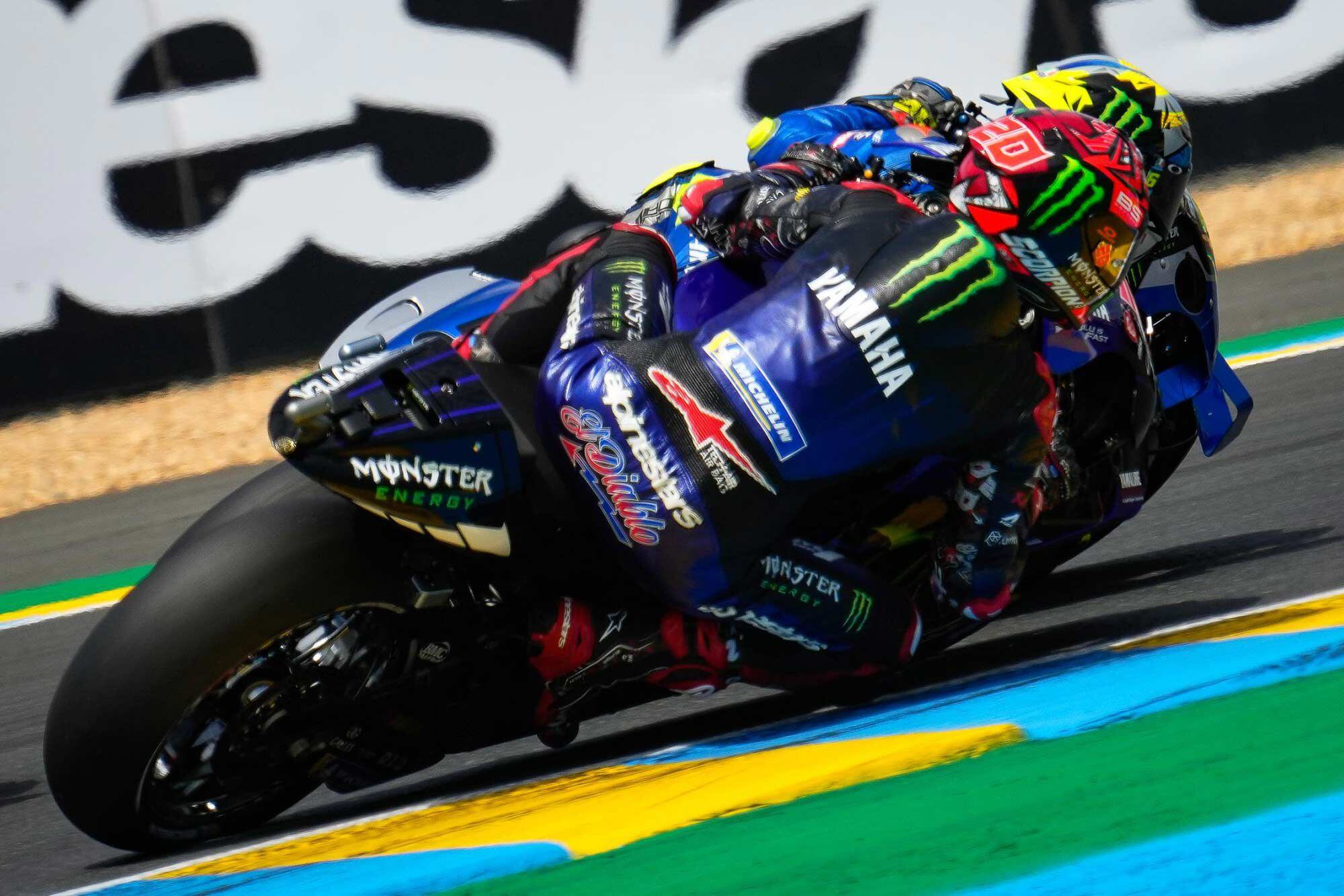 Yamaha’s Quartararo, the defending world champion, still holds the lead in the series, but he’s dogged closely by Aprilia’s Aleix Espargaró and Ducati’s Bastianini. At Le Mans he finished fourth, but at least he finished. (MotoGP/)On the other hand, I learned that the recommended inflation pressure for Michelin’s big rear slick of 2006 was 0.9 bar, or 13.23 psi. In addition, the development of automated tire building around 2000 achieved improved tire concentricity, allowing tires to use less tread rubber and therefore making them run cooler. Tire Pressure and Temperature A principal source of tire heating is the rubber’s internal friction, or hysteresis, generated as the tire flexes through the flat footprint during rotation. Around 2003 rival manufacturers discovered—with considerable interest—that Michelin made a practice of adjusting a tire’s operating temperature by adding or subtracting tread thickness. In other forms of racing, spec temperatures for tires are normal, and special “tire cooler” wheels may even be used. On Saturday Aleix Espargaró was asked about special tire-cooling rim paint: “Yes, it helps to disperse the heat better. We started using them in Indonesia this year, but it’s not the first time.” Finally, looking back a few years, at Daytona (always a scary place for a tire engineer) Michelin would station technicians at pit out to set the pressure in every Michelin tire rolling out to practice. Riders hated this; Michelin in its fear of negative PR wanted its tires inflated to high pressures, as though the banking was the entire track, leaving the riders to carefully slither and slide their way through the infield. Thinking riders therefore posted their own men at the far end of the pit lane, to reset the tires to the lower pressures they knew would give the best lap times. MotoGP’s “gentleman’s agreement” regarding tire pressure presently lacks the force of rule, but for next year the bikes are planned to have tire-pressure reporting devices supplied by a single provider, and all the units will be calibrated to report accurately. This will be a step forward from the two or three providers used at present. Thus, in 2023 it will become possible to actually enforce a tire-pressure rule—provided that physics does not in some way interfere with King Canute’s plans. Aerodramatics This brings us to the body of opinion now building against aero devices. The charge here is that the wakes they leave behind create the problems riders are currently experiencing when attempting to draft or pass. Ducati are seen as the originators of this problem. What will be proposed? Will there be a standard fairing form that all teams must use, much like NASCAR’s “car of tomorrow” body shape? Physics has already made bikes close in design. Aleix Espargaró said, “You have no idea how much every little difference can have incredible or disastrous effects on performance. A half degree can make the bike shake or slide away—it’s incredible. I think that now for the direction MotoGP is taking, with bikes that are more and more similar to each other, and stringent rules, each of these little things ends up by creating enormous advantages. “It is for this reason that we are trying not to revolutionize the bike. Every modification could completely destabilize the balance with the other components.” 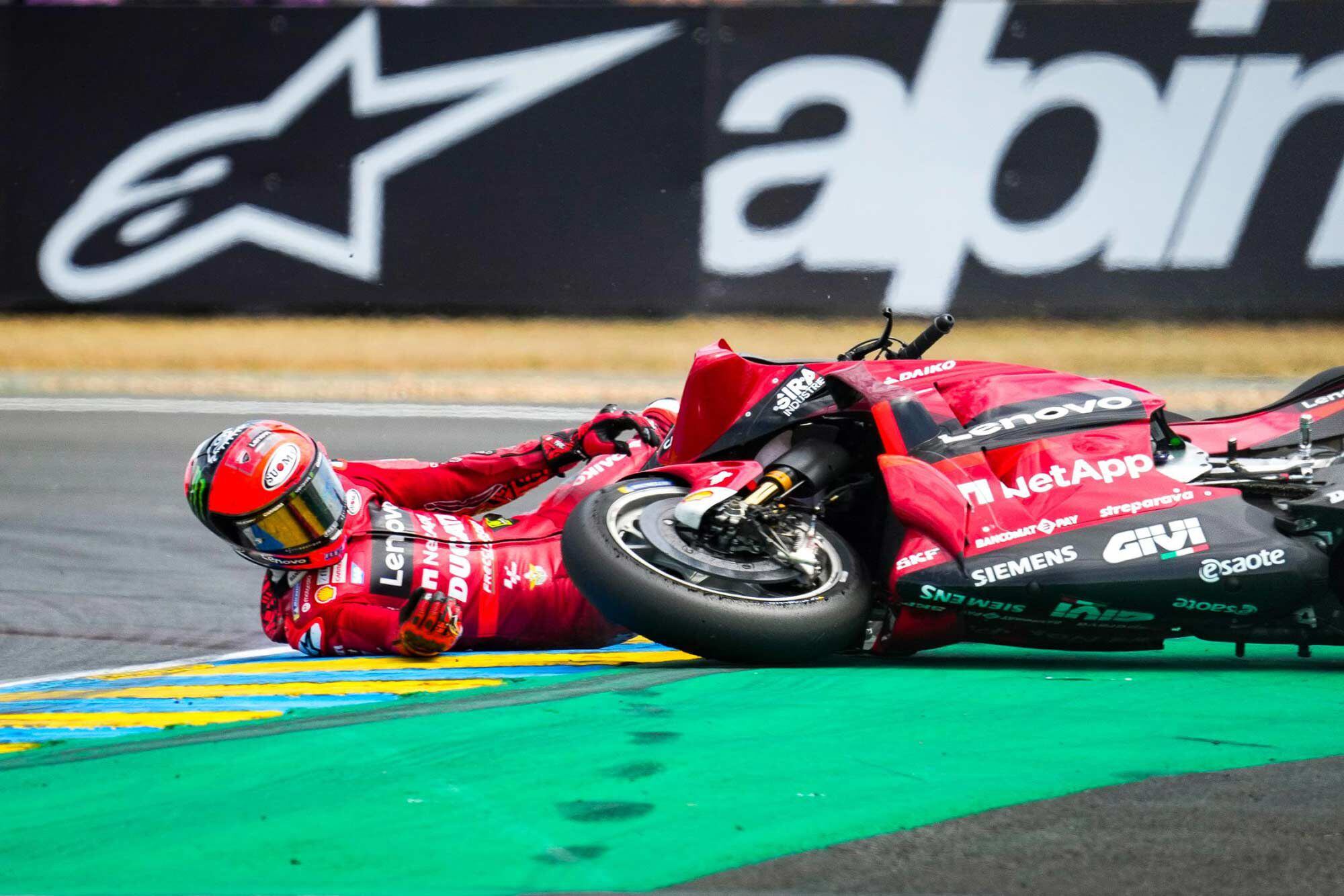 Le Mans was a crashfest, with six riders failing to finish. In qualifying, Francesco Bagnaia was golden, winning the pole and setting a new lap record. But on lap 21 his luck ran out while fighting for the lead. The DNF dropped him to seventh in the overall standings. (MotoGP/)A large reason for this observed extreme sensitivity is the closeness of the field, with 20 riders often in the first second behind the fastest. Dorna wants to drive the sport forward in popularity, and it sees heightened competitiveness as doing so. When all bikes have become similar not only in design but also in the fine details of their setup, tiny changes can, as riders have observed before, suddenly put you five places back. This also can magnify temperature-related changes in tire behavior, as in the large number of times riders have reported that “I was fast through practice, but the moment the race started I understood that something had changed, and I had little grip.” It takes time for information to diffuse from where it is being generated on the track by the riders, through bikes and crews, over to team management and race direction, then upward through the chain of command of manufacturers, of the series, of the makers of components, and to levels where policy is decided. We have seen that this process of diffusion may result in mistakes, as when a team whose bikes are designed for the point-and-shoot style hires a rider who is an extreme corner-speed specialist. Or another leading team hires a point-and-shoot rider to evaluate tires for a corner-speed teammate. Anyone at trackside level knows such combinations cannot work, but up at decision-making level, such information may be unavailable or considered unimportant. It will be fascinating to see if the “ban all aero” movement can get traction. Actual facts will have some say in how that goes, but the data can come only from the races yet to run. 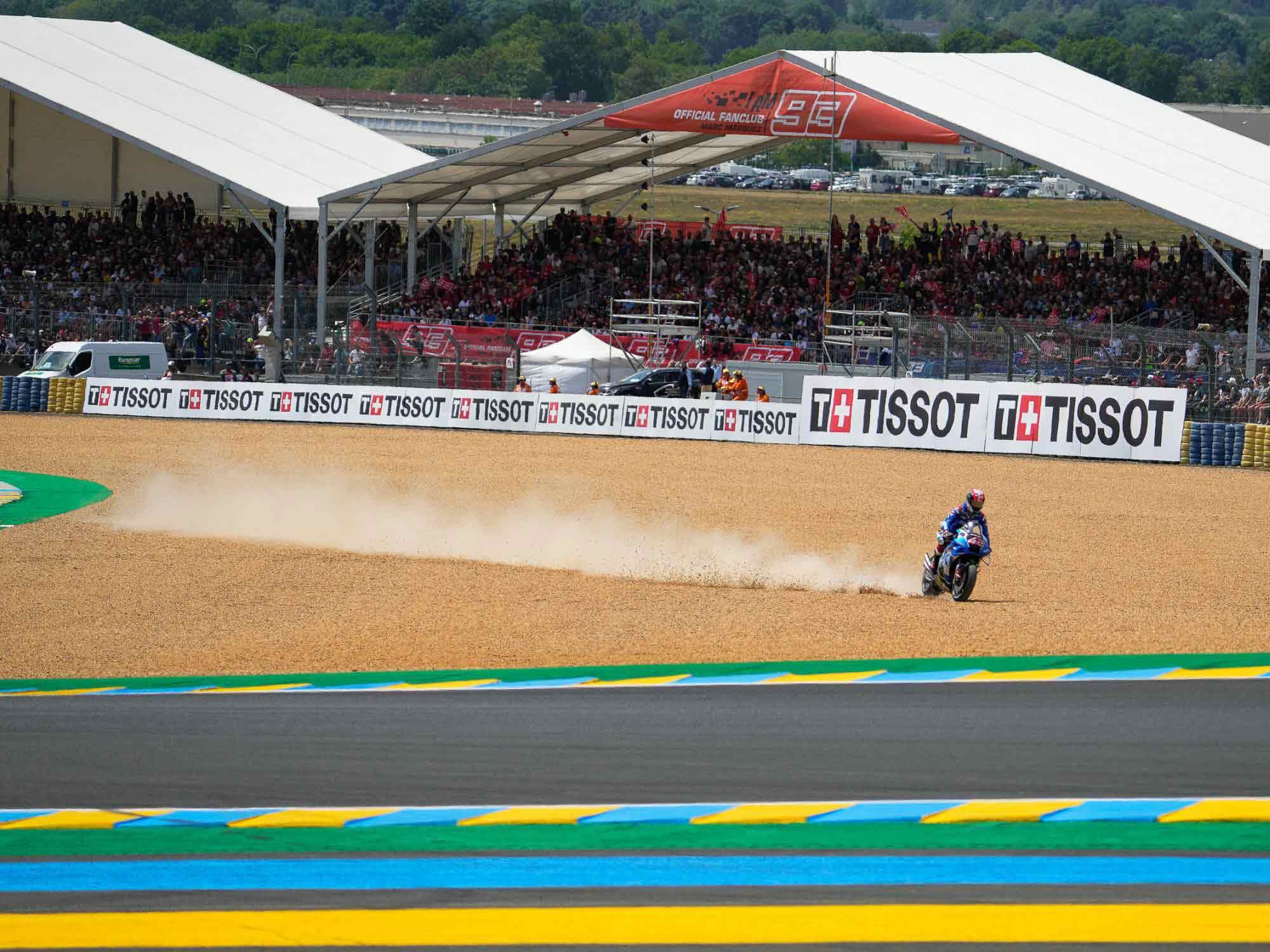 Suzuki’s planned withdrawal from MotoGP has been the talk of the pits. At Le Mans, neither Suzuki finished. Here, Álex Rins goes gardening on lap six. Teammate Joan Mir lasted until lap 14. (MotoGP/)
__________________________________________________
I'm a bot. I don't need no stinkin' signature... |
|
|

|
 |
 Similar Threads
Similar Threads
|
||||
| Thread | Thread Starter | Forum | Replies | Last Post |
| [cycleworld.com] - 2022 Kawasaki KLR650 | Ninjette Newsbot | General Motorcycling Discussion | 1 | May 15th, 2022 10:07 PM |
| [cycleworld.com] - 2022 KTM RC 390 | Ninjette Newsbot | Motorcycling News | 0 | May 10th, 2022 12:00 PM |
| [cycleworld.com] - 2022 Portimão MotoGP Report | Ninjette Newsbot | Motorcycling News | 0 | April 25th, 2022 04:02 PM |
| [cycleworld.com] - 2022 Honda CB500X | Ninjette Newsbot | Motorcycling News | 0 | April 20th, 2022 11:52 AM |
| [cycleworld.com] - 2022 Grand Prix of the Americas MotoGP Report | Ninjette Newsbot | Motorcycling News | 0 | April 20th, 2022 11:52 AM |
|
|